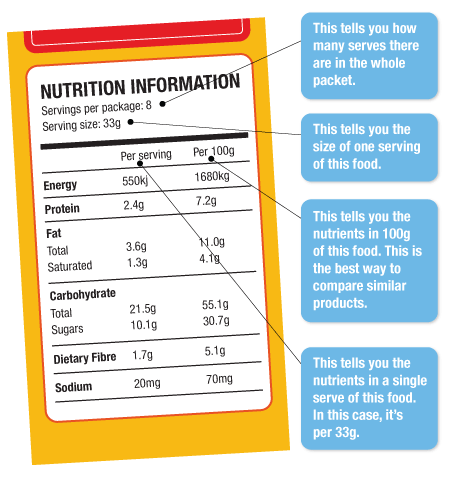Many of my clients have queries about food labels. This post is going to teach you a few things about what you need to look out for. First let me start by saying, the more foods we eat without food labels the better for our health. Eating less processed food will help us lose weight and avoid health problems. Foods should look like the plant or animal it came from and we shouldn’t need a food label to tell us what’s in it.
Serving Sizes
Always check the serving size, for example in a 500ml bottle of soft drink it will say 2 servings but who are we kidding no one drinks half a bottle then saves the other half for later. Always work out how many servings are in that package and how much you are going to consume yourself. If the serving size is ½ a cup and you are eating a whole cup then you are going to have to double the amount of calories and other nutrients.
Kilojoules and calories
One thing that most people get confused about is kilojoules (kJ) and calories. Both are measures of the amount of energy that’s in food. In Australia everything is now in kilojoules which is confusing because everything used to be calories. Kilojoules are also large numbers compared with calories which can also make it more confusing. We don’t believe you need to count calories however if you want an estimate of the amount calories in any food simply divide the kilojoules by 4. For example if the kilojoules are 2000 divide by 4 and that food has roughly 500 calories.
Ingredients List
In Australia all food labels have to list the ingredients. The list always starts with the ingredient that weighs the most and ends with the ingredient that weighs the least. Avoid products high in sugar, fat and salt. Here are a few ingredients to watch out for:
Sugars:
Brown sugar
Corn syrup
Dextrose
Fructose
Lactose
Maltose
Sucrose
Mannitol
Glucose
Honey
Malt
Maple Syrup
Fat:
Lard
Mayonnaise
Sour cream
Palm oil
Cream
Vegetable oil or fat
Dripping
Shortening
Salt:
Monosodium glutamate
Sodium bicarbonate m
Sodium metabisulphate
Sodium nitrate
Meat or yeast extract
Booster
Baking powder
Product Claims
Many products make different claims to make them more attractive to the consumer a few of these examples are:
• 80% fat free, which is the same as 20% fat which is high
• No added sugar but can still be high in natural sugar
• Baked not fried but can still be high in fat
• The term “light” may refer to colour, taste or texture
• Something might be low in fat but high in salt or sugar
Comparing Products
One of the best ways to compare products is by looking at the ‘per 100g’ or ‘per 100ml’ column.
As a general guide:
• Sugar should be less than 10g per 100g
• Fat should be less than 10g per 100g
• Saturated fat should be less than 3g per 100g
• Sodium should be less than 120mg per 100g

Leave A Comment